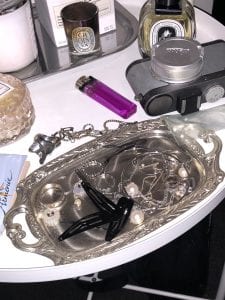Through this interview, I gained a new perspective on the styling choices of the person who I am very familiar with. I don’t think I ever related the subject positions of my interviewee to the way she dresses, but I think I came to relate the environmental aspects of her with the way she presents herself. One thing that I hadn’t noticed before was that she has an agency to go against the hegemonic divide between men and women by combining really feminine clothes such as peter pan collar shirt, laced dresses, and form fitting clothes and masculine clothing. She enjoys mixing menswear because she feels more comfortable and she wants to find a middle ground between ultra feminine and masculine clothing. She also values the the way an article of clothing is constructed and considers the materials so that it coordinates with the rest of her wardrobe and could last longer than any other type of clothing. These characteristics were influenced by her major and involvement in the artistic field as well as her middle class background. She clearly prioritizes the value and the durability of a well made piece of clothing because her father emphasized the importance of a long term investment in all aspects of life including clothing. I thought this was very similar to my dress practice because we share similar backgrounds and the way we approach fashion and examine clothing can be attributed to the nature of the Korean middle class. Another thing that I realized was that she only puts an effort into presenting her jewelry but not other clothes. This characteristic implies that her organization of clothing is very personal and self satisfactory. This also intersects with her design major because she emphasizes the unity of her furniture and her personal items she has collected for a long time. Author Joanne Entwistle stated that “the body is a highly restricted medium of expression that expresses the social pressure brought to bear on it.” My interviewee also said that her choice of clothing depends on the social situation. For example, she mentioned that she rarely wears Molly Goddard dress even though she really likes it because she feels that it is inappropriate to her daily routine. From this interview, I realized the impact of social context in daily dress practice. Before this interview, I was not conscious of the social pressure or constraints on the daily dress practice because I became accustomed to it.
Works Cited:
Entwistle, Joanne. “The Dressed Body.” Body Dressing Dress, Body, Culture, 2002.

